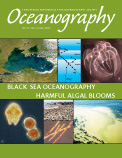First Paragraph
The California Current, Humboldt Current, Canary Current, Iberian Coastal System, and Benguela Current represent five Large Marine Ecosystems (LMEs) associated with eastern boundary upwelling regimes (Figure 1). LMEs are characterized by distinct bathymetry, hydrography, productivity, and trophically dependent populations. Most of the global ocean pollution, overexploitation, and coastal habitat alteration occurs within LME waters. The highly productive upwelling regimes account for a large fraction of global fisheries production (Figure 2), but similar to all other marine environments, are increasingly susceptible to the proliferation and negative effects of harmful algae (Figure 3). These impacts include human and marine organism illness and death due to direct toxic effects, environmental degradation due to, for example, increased biological oxygen demand, declining fisheries and growth of coastal communities, “nuisance” effects such as discoloration of the water, and more subtle changes to the ecology of these marine systems.

